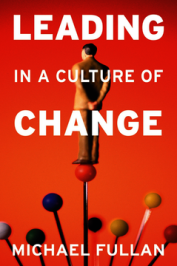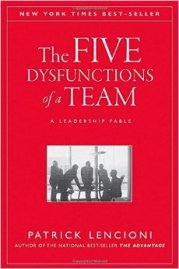This summer my reading was related to Leadership. Leadership Theory is a hugely diverse topic, with definitions and descriptions varying enormously between authors. What they all agree with is that we can find leadership in every sort of work, project and initiative, regardless of scale, finances or environment. Given the many ways in which leadership operates, it is no surprise then that leadership is so difficult to define and describe. Books that focus on leadership theory, be it philosophy, style, behaviour or technical models all suffer from dry writing and possibly confusing causation and correlation. However within the pages of the books I read are a few ideas that might be useful and possibly shape our approach within the PE classroom for the better.
 Coherence Making – The ‘world is not chaotic, it is complex’ and I would put forward this is the same for our classrooms. We as PE Teachers need to embrace this. The central tendency of a dynamic complex system, such as one of our PE classes, is to be constantly generating overload and causing fragmentation in thinking and doing. That the learning change we are trying to elicit in our pupils is going to be non-linear and messy. The experience of this messiness is necessary in order to discover hidden benefits. That of allowing pupils to make coherence out of that complexity. As long as we can keep our pupils safe, we can create an environment that allows their individual differences to surface. Coherence can only exist in the hearts and the minds of our individual pupils and we must allow them the chance to do that in their own time. Teaching uniformity may not allow them that opportunity. I have seen the benefits of both patience and a Teaching Games for Understanding approach has for my pupils over drilling out of context and will continue to look how to do that in other activities.
Coherence Making – The ‘world is not chaotic, it is complex’ and I would put forward this is the same for our classrooms. We as PE Teachers need to embrace this. The central tendency of a dynamic complex system, such as one of our PE classes, is to be constantly generating overload and causing fragmentation in thinking and doing. That the learning change we are trying to elicit in our pupils is going to be non-linear and messy. The experience of this messiness is necessary in order to discover hidden benefits. That of allowing pupils to make coherence out of that complexity. As long as we can keep our pupils safe, we can create an environment that allows their individual differences to surface. Coherence can only exist in the hearts and the minds of our individual pupils and we must allow them the chance to do that in their own time. Teaching uniformity may not allow them that opportunity. I have seen the benefits of both patience and a Teaching Games for Understanding approach has for my pupils over drilling out of context and will continue to look how to do that in other activities.
 Absence of Trust – Trust is at the heart of a functioning cohesive team. Our PE classes often act as teams, with many activities we teach requiring our pupils to work together in one way or another. In the context of a team, trust is the confidence among its members that their peers intentions are good. That everyone can be comfortable being vulnerable with each other. Teams that lack trust waste time and energy managing their behaviours and interactions within the group. This leads to a reluctance to take risks and lowers the enjoyment of being in that environment. It is our role as a teacher to try to create an environment that doesn’t punish vulnerability, by challenging and dealing with any behaviour that may do this, quickly and effectively. This will allow all pupils, no matter what their ability in PE, to flourish in the knowledge that they will be supported by their peers and by us. My personal feeling is that trust within the PE classroom is built out of clear routines, rules and expectations. That we as the teacher then uphold these, firmly but with care. Following through on them every time effectively. It is through doing that our pupils see us as being honest and having ability. This is how trust then begins to develop and our pupils then might feel more comfortable to take the risks needed to engage and improve in our subject.
Absence of Trust – Trust is at the heart of a functioning cohesive team. Our PE classes often act as teams, with many activities we teach requiring our pupils to work together in one way or another. In the context of a team, trust is the confidence among its members that their peers intentions are good. That everyone can be comfortable being vulnerable with each other. Teams that lack trust waste time and energy managing their behaviours and interactions within the group. This leads to a reluctance to take risks and lowers the enjoyment of being in that environment. It is our role as a teacher to try to create an environment that doesn’t punish vulnerability, by challenging and dealing with any behaviour that may do this, quickly and effectively. This will allow all pupils, no matter what their ability in PE, to flourish in the knowledge that they will be supported by their peers and by us. My personal feeling is that trust within the PE classroom is built out of clear routines, rules and expectations. That we as the teacher then uphold these, firmly but with care. Following through on them every time effectively. It is through doing that our pupils see us as being honest and having ability. This is how trust then begins to develop and our pupils then might feel more comfortable to take the risks needed to engage and improve in our subject.
Short Term Wins – Change takes time. Within PE real change may take a lot of time. We probably all talk to our pupils about the overall aims of PE regularly. We discuss long term effects of a healthy and physically active lifestyle and how this will benefit the quality of their life when they are older. However this sometimes means we forget the here and now. The enjoyment and the inherent value of moving, of being in the moment. It also means that we might forget that pupils want to see some evidence that their effort is paying off. Therefore attention to short term wins is just as important as achieving our overall aim. We need to plan for short term wins within our lessons and Schemes of Work. They need to be visible and unambiguous to our pupils, even better if a large number of them can all see the results. This in turn can prevent effort from dropping and provides us milestones and opportunities as teachers to share and celebrate success with all our pupils within PE.
A word of warning though. As a teacher I like to feel as if I understand and can control my teaching environment. I don’t like to think of myself as a helpless leaf blowing in the winds of chance when responsible for my pupils learning and engagement in life long pursuit of purposeful physical activity. So at times I may seek out and grab at any explanation of how things may work. My reading of Leadership Theory has provided me answers that I like to certain questions that I have about how both I and my pupils work (or don’t work). This however doesn’t necessarily mean that it is true or it is right. Everything I read fills my head with new bits of information. The more I have, the better-equipped I am to potentially tackle and find solutions to the challenges I face.


Great authors. Great little blog post
LikeLike
Thank you very much. Can you recommend any other authors on leadership?
LikeLike
Anything by Lencioni is great, and in a similar mould Simon Sinek. I’m a big wrap for Bob Sutton and Fullan is great for a school context. Fullan’s ‘The Principal’ should be read by every school leader
LikeLike
Great post! Time to put on the “Thinking Cap!”
LikeLike
Thanks Artie. Since I stopped watching television It has given me much more time to read and reflect. However I think I need to re-address the balance with just doing something that I’m completely immersed in, that I’m not thinking at all…..
LikeLike
You nailed it. Such important ideas. Establishing trust, coherence, and an environment that allows all students to find short term wins within their own circle of needs is paramount to finding long term success. Excellent summary of the leadership books that you read and the implications on how we teach. Thanks for sharing.
LikeLike
Thanks Andy. Of all of them I think Trust is key in our subject. Without it pupils won’t take the risk that moves them out of their comfort zone to try and experience new ways of moving, thinking, or interacting. The question the is how we build trust? For me I take a much more traditional approach that it is through fair and consistent application of the rules and routines in a caring manner shows that I’m both honest about what I say and do. This honesty then leads to them trusting me. What would be your approach of building trust?
LikeLike
It is so good to see what others are reading and how this is bouncing around in their minds as they apply this to PE and student learning. Leadership is one of the main focus’ for our school this year and within this Student leadership – and I am excited to see how we can grow this in our PE curriculum and strengthen this. We are very lucky in our environment as I can see that we are in a new space with lots of trust and a growing teamwork that is improving due to feeling secure. New students arrive and they feel as if they have to prove themselves, but there is not a culture of that at our school, and soon they realise that all they have to do is get on with what is expected of them as their classmates for the most part are – and they are fine. Not to say that we don’t have bullies or people who are mean – we do, but it is not as obvious or as big an issue as I have seen in other schools. I believe that Leadership is also about offering opportunity to kids to grow and try out new ideas and to let them succeed or fail with support – they don’t have to go it alone, you are there to support them and to let them sound out their ideas. Leadership is not always the loud person – the supporting player or the one asking questions or going with the motivational move (Teacher says “can everyone come over here please?” and that first student who moves and creates the momentum is the intrinsic leader here) they are leaders too – and having kids trust that this internal dialogue is valued and a part of learning is so important to embrace as teachers. Thank you for sharing some new books to read – sounds like you have a lot to consider this year.
LikeLike
The more I read on leadership, the less I like the term Leader. There seems to be a promotion to set leaders apart from the people they are responsible for, that they are some sort of special being. Simon Sinek in the opening of his excellent book ‘Start with Why’ writes ‘There are leaders and those that lead. Leaders hold a position of power. Those that lead inspire us. Whether individuals or organisations, we follow those who lead not because we have to, but because we want to. We follow those that lead not for them, but for ourselves.’
LikeLike